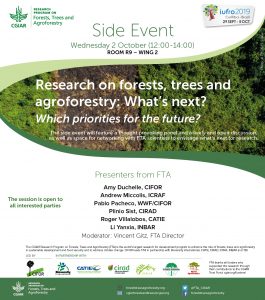FTA side event
Given the incredible amount of new findings presented by thousands of scientists from so many organizations from all over the world gathered in Curitiba (Brazil), What’s next for forestry?
The XXV IUFRO Congress brings together the latest from forest science. It is also inserted in a very dense international agenda: climate week NYC, COP25, heading to 2020 which will be a key year for the Rio Conventions, the start of a key decade for mankind and the planet.
FTA, the world’s largest R4D program in the area of forests, trees and agroforestry, would like to take this opportunity to exchange, with all interested scientists attending the conference, views and perspectives on what needs to be prioritized for future forest research.
The session is open to all interested parties.












